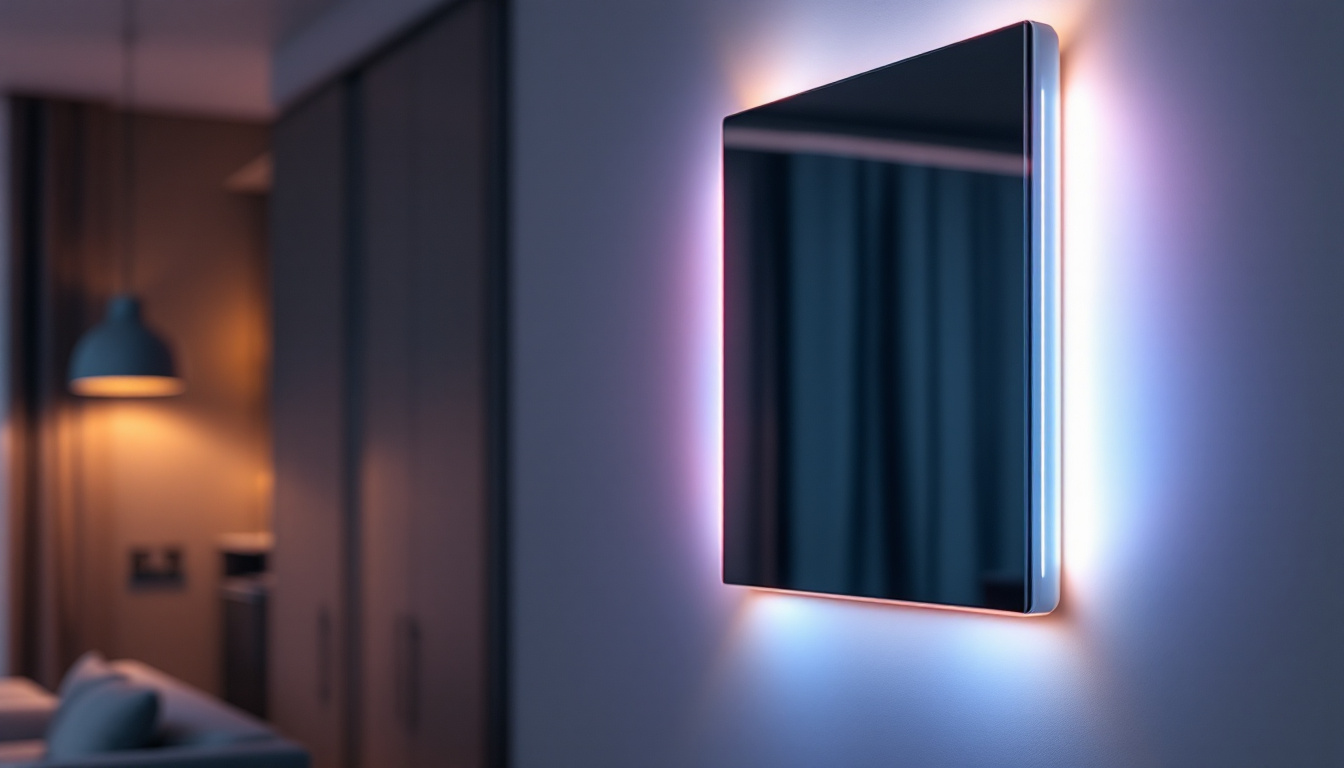
lighting design has evolved significantly over the years, and with the advent of smart technology, the industry has witnessed a paradigm shift. Among the many innovations, the LED strip wall-mounted smart panel for Correlated Color Temperature (CCT) stands out as a game-changer for lighting contractors. This technology not only enhances the aesthetic appeal of spaces but also provides unparalleled control over lighting environments.
Correlated Color Temperature (CCT) is a crucial aspect of lighting design, referring to the color appearance of the light emitted by a source, measured in Kelvin (K). It plays a significant role in setting the mood and functionality of a space. For lighting contractors, understanding CCT is essential for creating environments that meet the specific needs of clients.
Different CCT values convey various atmospheres; for instance, lower values (2700K-3000K) produce a warm, cozy feel, ideal for residential settings, while higher values (4000K-5000K) provide a cooler, more energizing ambiance suitable for offices or retail spaces. By leveraging CCT, lighting contractors can tailor their designs to enhance the user experience. The psychological effects of color temperature are profound, as warmer tones can promote relaxation and comfort, making them perfect for bedrooms and living areas, whereas cooler tones can stimulate alertness and productivity, making them ideal for workspaces and educational environments.
LED strip lighting has gained popularity due to its versatility and efficiency. These flexible strips can be easily mounted in various locations, allowing for creative lighting solutions. The integration of CCT capabilities into LED strips enables contractors to offer dynamic lighting options that can change according to the time of day or the specific needs of a space. For instance, a restaurant might use warmer tones during dinner service to create an intimate atmosphere, then switch to cooler tones during lunch hours to energize patrons and enhance visibility.
Moreover, LED strips consume less energy than traditional lighting solutions, making them an environmentally friendly choice. This aspect not only appeals to eco-conscious clients but also helps contractors reduce energy costs in their projects. Additionally, LED technology has advanced to include features such as color tuning and smart controls, allowing users to adjust the color temperature and intensity with the touch of a button. This adaptability not only enhances the aesthetic appeal of a space but also allows for greater functionality, as different lighting scenarios can be created for various activities, from hosting gatherings to focused work sessions. As the demand for customizable lighting solutions continues to grow, the role of LED strip lighting in modern design is becoming increasingly significant.
Wall-mounted smart panels equipped with CCT functionality provide contractors with a powerful tool to manage lighting effectively. These panels allow for easy adjustments to color temperature and intensity, enabling users to create the desired ambiance with a simple touch or swipe. The intuitive interface of these panels means that even those who are not tech-savvy can quickly learn to navigate the system, making them accessible for all users. This user-friendly design is crucial in ensuring that clients feel comfortable and confident in utilizing the technology to its full potential.
One of the primary advantages of using smart panels is the ability to program lighting schedules. This feature is particularly beneficial in commercial settings, where lighting needs may change throughout the day. By automating lighting controls, contractors can enhance energy efficiency and improve the overall user experience. For instance, in a retail environment, lighting can be programmed to brighten during peak hours to attract customers and dim during quieter times, thus saving energy without compromising on ambiance.
The customization options available with smart panels are extensive. Contractors can set different scenes for various activities, such as reading, entertaining, or working. This level of control allows clients to tailor their environments to suit their preferences, making the spaces more functional and enjoyable. Moreover, the ability to adjust settings based on the time of day or specific events means that users can create a dynamic atmosphere that evolves with their needs, enhancing the overall experience within the space.
Additionally, many smart panels can be integrated with home automation systems, allowing for seamless control of lighting alongside other smart devices. This integration not only simplifies the user experience but also adds value to the overall project. For example, a homeowner can set their smart panel to work in conjunction with smart thermostats and security systems, creating a holistic approach to home management. This interconnectedness not only streamlines daily routines but also provides peace of mind, as users can monitor and adjust their home environment from anywhere, using their smartphones or tablets. As technology continues to advance, the potential for further innovations in smart panel capabilities will only enhance their appeal and functionality in modern homes and businesses.
When installing LED strip wall-mounted smart panels, contractors must consider several factors to ensure optimal performance and user satisfaction. Proper placement of the panels is essential, as it affects both functionality and aesthetics. Panels should be easily accessible yet discreet enough to blend with the interior design. For instance, positioning panels near common areas or high-traffic zones can enhance usability, while ensuring they do not disrupt the visual flow of the space. Additionally, contractors should take into account the height at which panels are mounted, as this can influence both ease of use and the effectiveness of the lighting.
Furthermore, contractors should be familiar with the electrical requirements and compatibility of the smart panels with existing systems. Ensuring that the panels can communicate effectively with other devices is crucial for achieving the desired level of control and automation. This includes understanding the specific protocols used by the smart panels, such as Zigbee or Z-Wave, and ensuring that the home’s network infrastructure can support these technologies. A thorough assessment of the existing wiring and circuit load is also necessary to prevent any potential overloads or malfunctions.
As technology continues to advance, ongoing training and support for contractors become increasingly important. Familiarity with the latest smart panel features and installation techniques will enable contractors to provide the best service to their clients. Many manufacturers offer training programs and resources to help contractors stay updated on new products and technologies. These programs often include hands-on workshops, online courses, and access to product manuals, which can significantly enhance a contractor’s skill set and confidence in handling complex installations.
In addition, providing clients with guidance on how to use their new lighting systems can enhance customer satisfaction. Offering post-installation support can also lead to repeat business and referrals, which are vital for a contractor’s success. By creating user-friendly instructional materials or conducting follow-up sessions, contractors can empower clients to fully utilize their smart panels’ capabilities. This not only fosters a sense of trust and reliability but also positions the contractor as a knowledgeable resource in the rapidly evolving landscape of smart home technology. As clients become more familiar with their systems, they may also seek further enhancements or upgrades, presenting additional opportunities for contractors to expand their services.
In a competitive market, effectively marketing the benefits of LED strip wall-mounted smart panels can set a contractor apart from the competition. Highlighting the energy efficiency, customization options, and ease of use can attract clients looking for modern lighting solutions.
Utilizing social media platforms and online portfolios to showcase completed projects featuring smart panels can also enhance visibility and attract potential clients. Testimonials from satisfied customers can further bolster credibility and demonstrate the value of these innovative lighting solutions.
Building relationships with other professionals in the industry can provide valuable opportunities for contractors. Collaborating with interior designers, architects, and builders can lead to referrals and joint projects that showcase the versatility of smart lighting solutions.
Participating in industry events and trade shows can also help contractors stay connected with trends and innovations in lighting technology. Networking with peers can lead to knowledge sharing and potential partnerships that enhance business growth.
The future of smart lighting is bright, with continuous advancements in technology paving the way for even more innovative solutions. The integration of artificial intelligence (AI) and machine learning into smart lighting systems promises to further enhance customization and user experience.
As these technologies evolve, lighting contractors must stay informed about emerging trends and adapt their offerings accordingly. Being at the forefront of these developments will not only improve service delivery but also position contractors as industry leaders.
With growing awareness of environmental issues, sustainability will continue to be a driving force in the lighting industry. Contractors who prioritize energy-efficient solutions and eco-friendly practices will be better positioned to meet the demands of conscious consumers.
Incorporating sustainable practices into business operations, such as using recyclable materials and minimizing waste during installations, can enhance a contractor’s reputation and appeal to environmentally minded clients.
The integration of LED strip wall-mounted smart panels for CCT color temperature represents a significant advancement in lighting technology. For lighting contractors, embracing this innovation is essential for staying competitive in an ever-evolving market. By understanding the importance of CCT, leveraging the benefits of smart panels, and focusing on customer satisfaction, contractors can enhance their service offerings and drive business success.
As the industry continues to evolve, staying informed about technological advancements and market trends will be crucial. By investing in training, marketing, and networking, lighting contractors can position themselves as leaders in the field, ready to meet the lighting needs of tomorrow.
Ready to elevate your lighting projects with the innovative LED strip wall-mounted smart panels for CCT color temperature? At LumenWholesale, we provide lighting contractors with the superior, spec-grade lighting products you need to stay ahead of the curve. Enjoy the benefits of our extensive selection and wholesale pricing, ensuring your projects shine with reliability and high performance. With free shipping on bulk orders, you can trust that you’re getting the best value without any hidden costs. Make your next project a beacon of quality, affordability, and convenience. Wholesale Lighting at the Best Value is just a click away.

Discover how Bulb Cellars is revolutionizing the bidding process for lighting contractors.

Discover how purchasing a 10-pack of linkable shop lights on eBay can revolutionize your lighting projects.

Discover how chain hanging lights can revolutionize the workflow of lighting contractors by enhancing efficiency and flexibility.

Discover effective strategies for lighting contractors to tackle common challenges when installing pendant chandeliers.